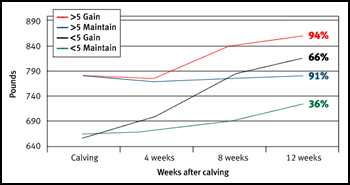
Rick Rasby
Ridin’ Herd
What if spring-calving cows are thin now?
The winter and early spring was long and tough, and breeding season is just around the corner for March-calving herds. In many areas, cornstalk acres and some of the stockpiled winter range were not available this winter for grazing. Harvested feeds were fed for a longer period of time this past winter. Cows seemed to be in lower body condition at calving, and they are entering the breeding season possibly in lower condition. What options are there from a nutritional perspective?
Flushing beef females
Flushing is a concept that has been used in the swine industry to increase the number of eggs ovulated in sows. Flushing is a management term for providing high-quality feeds, usually grains, prior to the start of the breeding season to increase reproductive performance. Can this concept be applied to beef females that calve in less-than-adequate body condition?
David Lalman at Oklahoma State University (OSU) conducted research investigating the effects of changing body condition after calving on pregnancy rate in first-calf cows (see Fig. 1). As expected, young females that calved in a body condition score (BCS) of less than 5 (green line) and maintained BCS through 12 weeks postcalving had the lowest pregnancy rates. Heifers that calved in a BCS of less than 5 (black line) and then were fed increased energy postcalving — somewhat like flushing the female because there is a substantial increase in weight gain in these heifers — achieved a pregnancy rate of 66%, which is well below an acceptable rebreeding rate for females during their second breeding season.
Interesting in this data set is that heifers that calved in a BCS of greater than 5 and were fed extra energy after calving (red line) had only 3 percentage units higher pregnancy rate compared to heifers that calved in a similar BCS and did not lose weight postcalving (94% vs. 91% pregnancy rate). Bottom line, in this data set trying to play catch-up on body condition prior to the start of the breeding season did not work.
Postcalving management effects
OSU researchers reviewed 53 reports published from 1970 to 2004 on the effect of postcalving nutrition and management in heifers calved first at 2 years of age. The review indicated that pregnancy rates are similar in both first-calving and older females, but that longer postpartum intervals to first estrus and decreased pregnancy rates are common in rebreeding first-calf cows.
So, higher nutrition and management are required if acceptable performance is to be realized from rebreeding 2-year-olds. Dietary energy restriction has the opposite effect on those two responses, regardless of age or parity. In the review, neither dietary fat nor undegraded intake protein (UIP) supplementation consistently improved reproduction in first-calf cows.
The greatest positive effect on reproduction in rebreeding first-calf cows was realized from managing for body condition before calving so they calve in adequate BCS (BCS 5.5 to 6.0) and providing adequate nutrition to minimize loss of condition and body weight after calving. The authors noted that positive effects from good management must be balanced against any corresponding costs. This information can be found in the June 2005 issue of the The Professional Animal Scientist (21:151), available online at http://pas.fass.org/content/21/3.toc.
There was a study where the researchers recorded the "flushing" effect on cows. Thin cows in this study were underfed until 14 days before the start of the breeding season and then fed a high-energy diet from 14 days prior to the start of the breeding season until 30 days into the breeding season. They recorded a response in percent pregnant to flushing. The "flush" diet consisted of 8.8 pounds (lb.) to 13.2 lb. of ground corn per head per day and corn silage free choice. As one might expect, these diets changed cow body condition. Also, as BCS increased, so did milk production.
Options for thin cows prior to breeding season
Short-term calf removal is the term that describes the temporary physical separation of the calf from its mother. This removes the nursing stimulus from the cow for about two days. Removing the suckling stimulus can encourage a few cows to start having estrus cycles a few days sooner than otherwise would occur. Removal of calves for 48 hours has shown to improve rebreeding rates of moderately conditioned (BCS 4 to 5) cows by 4%-8%. This improvement, although seemingly small in magnitude, is substantial compared to the out-of-pocket investment.
Short-term calf removal can be used at the first of the breeding season or in the middle or both depending on the labor situation. Do not expect short-term calf removal to replace normal good nutritional management. Short-term calf removal is not a powerful enough stimulus to jump-start very thin cows. Those that are in a BCS of 4 or less may need to have the calves weaned completely to allow the cow to recycle early in the upcoming breeding season.
The care of the calf during that 48 hours is actually quite simple. Most producers will make certain that calves have access to some "sweet" feed and plenty of fresh drinking water. The calves will eat very little during this time.
There is a myth that time of suckling during the 24-hour day influences return to estrus. There are no data that would support day-only nursing or night-only nursing having any effect on postcalving return to estrous cycles.
Final thoughts
Playing catch-up after calving is usually expensive and not practical. There are data that indicate that 70% of the supplemental energy fed postcalving is partitioned to milk production. The "flushing" concept, when it comes to nutritional management of beef females, seems to not be reliable without a lot of energy in the diet. A 48-hour calf removal could be an option if needed. Manage for body condition before calving and work to at least maintain BCS postcalving.
[Click here to go to the top of the page.]







